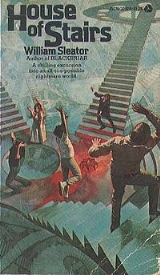
House of Stairs
Encyclopedia
- For other works titled House of Stairs, see House of Stairs (disambiguation)House of Stairs (disambiguation)House of Stairs is a lithograph print by the Dutch artist M. C. Escher, and it also may refer to:* House of Stairs * The House of Stairs...
.
House of Stairs is a lithograph
Lithography
Lithography is a method for printing using a stone or a metal plate with a completely smooth surface...
print by the Dutch
Netherlands
The Netherlands is a constituent country of the Kingdom of the Netherlands, located mainly in North-West Europe and with several islands in the Caribbean. Mainland Netherlands borders the North Sea to the north and west, Belgium to the south, and Germany to the east, and shares maritime borders...
artist M. C. Escher
M. C. Escher
Maurits Cornelis Escher , usually referred to as M. C. Escher , was a Dutch graphic artist. He is known for his often mathematically inspired woodcuts, lithographs, and mezzotints...
which was first printed in November 1951. This print measures 18⅝" × 9⅜". It depicts the interior of a tall structure crisscrossed with stairs and doorways at paradox
Paradox
Similar to Circular reasoning, A paradox is a seemingly true statement or group of statements that lead to a contradiction or a situation which seems to defy logic or intuition...
ical angles. The basic structure of the stairs and platforms is modeled on the Penrose triangle
Penrose triangle
The Penrose triangle, also known as the Penrose tribar, is an impossible object. It was first created by the Swedish artist Oscar Reutersvärd in 1934. The mathematician Roger Penrose independently devised and popularised it in the 1950s, describing it as "impossibility in its purest form". It is...
, or "impossible triangle", which has parallels with higher-dimensional analogs of the Möbius strip
Möbius strip
The Möbius strip or Möbius band is a surface with only one side and only one boundary component. The Möbius strip has the mathematical property of being non-orientable. It can be realized as a ruled surface...
.
A total of 46 "wentelteefje
Curl-up
Curl-up or Wentelteefje is a lithograph print by M. C. Escher, first printed in November 1951.This is the only work by Escher which consists largely of text. The text, which is written in Dutch, describes an imaginary species called Pedalternorotandomovens centroculatus articulosus, also known as...
" (imaginary creatures created by Escher) are crawling on the stairs. The wentelteefje has a long, armored body with six legs, humanoid feet, a parrot-like beak and eyes on stalks. Some are seen to roll in through doors, wound in a wheel shape and then unroll to crawl up the stairs, while others crawl down stairs and wind up to roll out. The wentelteefje first appeared earlier the same month in the lithograph Curl-up
Curl-up
Curl-up or Wentelteefje is a lithograph print by M. C. Escher, first printed in November 1951.This is the only work by Escher which consists largely of text. The text, which is written in Dutch, describes an imaginary species called Pedalternorotandomovens centroculatus articulosus, also known as...
. Later that month, House of Stairs was extended to a vertical length of 55½" in a print titled House of Stairs II by repeating and mirroring some of the architecture and creatures.

